48 Hours in Zanzibar
Before my visit, Zanzibar exists only as an adventure destination. As the gateway of East Africa, Zanzibar island is historically and strategically important, renowned as the other capital of the Sultanate of Oman. Every corner in its commercial center, Stonetown, a renowned UNESCO World Heritage, is a discovery by itself, from old Omani palaces, to historical slave monuments, Persian baths and quaint mosques and churches. I’m not sure if I have ever been in Zanzibar for more than 2 days but having visited the island four times in the recent past, I will try to distill here what one should not miss.
Day One
the Slavery memorials
Do you know that Zanzibar was the major port of slaves in East Africa? Hundreds of thousands of men and women were auctioned off in the small island and sold as slaves all throughout its history, most recently and notably in the 19th century. If only to be reminded of the oppression and inhumanity of slavery, do not miss visiting the somber vestiges of the slave trade in a small area around the Anglican Church which was built when slavery was outlawed in the island. The memorials are grim and gritty. The auction site by the courtyard is nondescript. The adjacent slave dungeons turned museum are dusty and clautrophobic. The statuary memorial of slaves is graphic and without pomp. Even the church altar is dark and desolate, befitting of a former site of the whipping post. Slavery, after all, is not meant to be glorified and glazed.
travel tip: Do this in early morning or late afternoon. Most of these places get too hot in noontime. Estimated time of 1-1.5 hours
Canon EOS 350D, 0.006s, f/7.1, 30mm, ISO 100, cropped
”Memory for the slaves” by Clara Sornas, at the former auction square in front of the Anglican Church, Zanzibar
the spice trail
Zanzibar, is the SPICE ISLAND of Africa. Being on the equator, it enjoys a tropical rainy climate. Several reputable travel agencies in Zanzibar flaunt the island’s imminent status by offering organized spice tours in plantations. As every conceivable spice is crammed in one easily navigable area, you can conveniently see in their natural habitat patches of cinnamon, cumin, pepper, cardamon, and turmeric, among others. With matching commentaries on the uses and history of the spices, the tour also features visit to a small makeshift market of native delicacies, fruits and souvenir packs of spices (all for sale of course). And for a small gratuity, you get to leave with speedily woven coconut leaf items like a necklace wallet, a basket or a hat.
travel tip: If you are already familiar with tropical fruits and spices, you may skip this. I was there just for the photo ops. Estimated time of 2-1.5 hours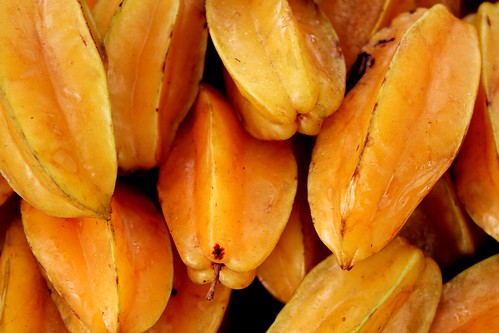
Canon EOS 350D, 0.008s, f/5, 40mm, ISO 200
starfruit for sale at a farm in Kzembani-Kdechi, Zanzibar, Tanzania, East Africa
the sandy beaches
Of course, do not resist the invite of the wide empty sand beaches of Zanzibar. Fortunately for me, my work requires plenty of duty calls to the beach. Having visited quite a fair share, I recommend Paje in the Southeast or Mchangani in the Northeast. For lunch, there are numerous choices of hotels and restaurants to enjoy both fresh seafood and the surf.
Zanzibar does not have lots of paved roads outside of the main highways so the peripheral villages along the coast basically use the white expanse of the beach as the convenient highway. The setup is perfect setting then for a stakeout of street photography. Think of hijab-wearing school children going home, wildly colored batik-printed cotton clothes being dried on lines, mothers bathing their babies and my favorite, seaweed being harvested.
travel tip: Check the tide table. Tide differences in East Africa are about 8 meters (compare that to 1 meter in the Philippines!) so be wary of tidal surges. There are a lot more action (fishing, beachcombing, seaweed harvesting) during low tide. Estimated down time is 3 hour, more if you do water sports.
Canon EOS 350D, 0.01sec, f/22, 18mm, ISO 100
pedestrian traffic at Paje Beach, Southeast Zanzibar, Tanzania, Africa
Let me not romanticize Zanzibar. Poverty is pervasive and the life expectancy is short, a shocking 45-46 years. Jobs are scarce, especially for women. Take the woman below, for example. What she was digging out of the sand were coconut husks that she buried 4 to 6 months ago, marked only those old tires. The coconut coir fibers apparently already are “ripe” for harvesting. Soft and pliant, the fibers are wound as rope or sold as mattress fill. A few dollars can go a long way in Zanzibar.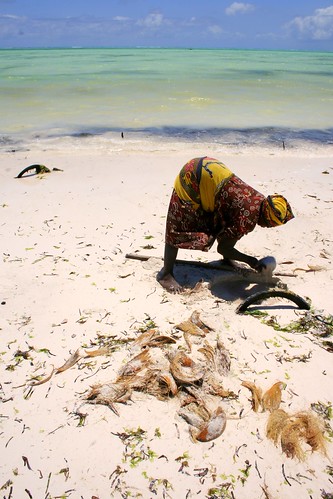
Canon EOS 350D, 0.01s, f/22, 18mm, ISO 100
Paje beach, Southeast Zanzibar, Tanzania, East Africa
the sunset over the Zanzibar Channel
Just before sundown, head back to Stonetown and settle in a cozy spot overlooking the Zanzibar Channel. Probably the cheapest food you will find on the island is at the night market of the Forodhani Gardens. Local cuisine from seafood to pizzas to vegetarian Hindu dishes are available for the picking. Down them with juice drinks of fresh sugar cane, coconut or even hibiscus (red and sweet!). Another option will be Mercury’s Bar which literally juts over the sea. Watch out for the dhows going home for the day or leaving the docks with tourists out for a dinner cruise.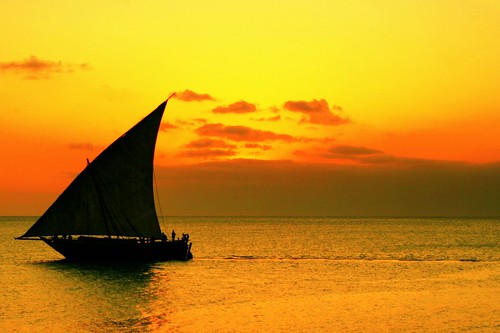
Canon EOS 350D, 0.02s, f/16, 52mm, ISO 100
a dhow sunset at the Zanzibar Channel , Zanzibar, Tanzania, East Africa
Day Two
Stonetown
On day 2, get a map of Stonetown and explore the unique UNESCO World Heritage city. It can really be explored by walking although you may need transport to zip from one end to the other. Zanzibar is generally safe, but as in any city, be careful and do not be an easy target of petty crime. Don’t mind getting lost in the winding narrow alleys- people are friendly. Besides, the next corner always promises another surprise. Hunt for old mosques, quaint coffee houses, bustling market squares, curious old courtyards, colorful art and antique galleries and of course, the fort-like cluster of stone houses. Start southwest and head north to pass by the Kelele Square, the Africa House, St. Joseph’s Cathedral, the Arab Fort, the House of Wonders and the Forodhani Gardens. Further up the in the northeast are the Old Dispensary and the Mnara mosque (in Malindi) famous for its unique conical minarets.
the doors! the doors!
All throughout the walk, you will be greeted by the everpresent indelible symbol of Stonetown: the Zanzibar doors. Fused from the influences of the Arabic, the Indian and the native, these doors are deeply carved, expertly joined and smacked with studs and bosses of iron or brass. My favorite past-time is photographing these antique wooden doors, if only to commit to documentary evidence that once, they have existed. Restoration funds, like in any third world country, are wanting in Zanzibar and many a door lie wasted by time. If you can find a copy, grab the book, Doors of Zanzibar. Photographed by Uwe Rawu and written by Mwalim Mwalim, the book lays out a map of some 200 heritage portals in Stonetown.
travel tip: The town is safe so you can do without a travel guide if you choose. You may need local transport though like a motorcycle or a car to shorten your tour to 3-4 hours. 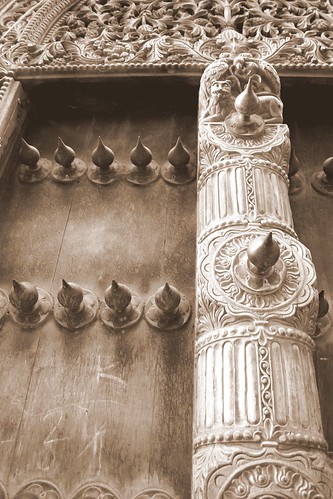
Canon EOS 350D Digital, 0.25s, f/4, 18mm, ISO 100
the Simhogo Door, Baghani Street, Zanzibar Island, Tanzania, East Africa
Do not miss the grand St. Joseph Cathedral. One time I even heard a 6:30AM mass in this century old church in Swahili! I could not understand a word but the atmosphere was welcoming. The church interiors scream like a movie set to me: pillars of dark-veined marble, ionic columns in flashy pink, flaking murals on the ceiling, colorful European tiles and rare gothic pews in iron and wood. Gladly, Muslim Tanzania is admirably religiously tolerant.
travel tip: Befriend a nun or a caretaker in the St. Joseph Church. If you’re lucky, you may get ushered into the fabulous church choir loft to take in a more breathtaking view. 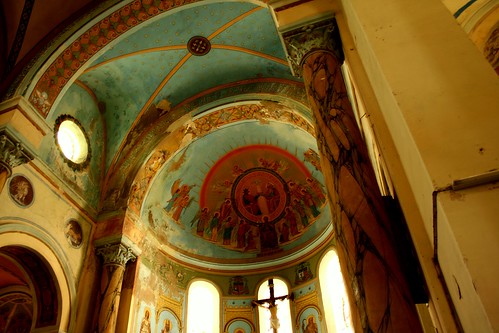
Canon EOS 350D, 0.6s, f/4.5, 30mm, ISO 100
St Joseph's Cathedral, Stonetown, Zanzibar, Tanzania
the palatial ruins of the Old Sultanate
Remnants of the Old Sultanate are everywhere. In the 1800s, the Omani Sultan, attracted by the booming enterprises of cloves, ivory and slaves, transferred the capital of the Sultanate to rich Stonetown. Several kilometers from Stonetown sit the ruins of what once was the Marhubi Palace. Grandeur lost can still be grandeur imagined. Built specifically for the sultan's harem, it used to be a glorious site of domed pavilions, manicured garden, fruit groves, fountains, shower rooms (which are domed roofs with holes for rainwater to “shower” down) and Persian baths. Water then was fed by an extensive aqueduct. Burnt down in 1890, it still is romance in stone. 
Canon EOS 350D Digital, 0.033s, f/22, 28mm, ISO 100, uncropped
the palace of Marhubi, Unguja Island, Zanzibar, Tanzania, East Africa
If I remembered right, near this palace is a dhow workshop. Up to now, dhow-making is a sustainable industry in Zanzibar where a sizeable commercial fishing vessel of teak construction may cost around $10,000. Watching how these boats made the traditional way is a treat.
To continue the tour of the Old Sultanate ruins, venture further to the Persian baths of Kidichi. Originally, these baths were open to both men and women only that they had separate hours of admittance – women in the mornings and men in the afternoons. It was (and still is) customary for married Muslim men and women to rid themselves of all body hair so shaving vestibules were provided within the bathhouse.
travel tip: Estimated travel and tour time is 2 hours 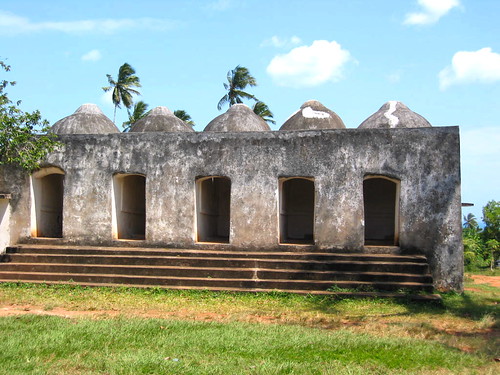
Canon PowerShot S40, 0.001s, f/3.5, 10.3 mm
Persian Baths of Kidichi
the House of Wonders
The heritage trail will not be complete without the National Museum or the Beit al-Sahel (“The Palace by the Sea”), popularly referred to as the House of Wonders. Built in 1883, it was the town palace of the Sultan of Oman. The House of Wonders is a truly remarkable building which is now more than 100 years old. It is one of the largest edifices in the island and boasts of the first to have electric light and elevator.
Jozani Forest
Escape to nature. The Jozani Forest Nature Reserve is a popular trail which showcases local birds, the rare duiker antelope and the red Colobus and Syke’s monkeys. This is a separate tour itinerary which I purposedly missed out as I already passed by the forest on the way to Paje beach. There are also lots of baobabs around this area. Baobabs are like uprooted trees which seem to have the roots for their canopy.
authentic Zanzibari food and music
To end the memorable journey, splurge at the ocean-view Baharia restaurant of Serena Inn. Overlooking the Zanzibar Channel, it offers authentic African dishes, as well as international fare, under the ambiance of traditional African and Arabic architecture, complete with fantastically colored skylights and intricately pierced-and-cut tracery windows. The restaurant offers nightly authentic performances of a Taarab orchestra which is an amalgam of African, Arabic and Indian music favored by Sultan of Oman. If all else fails, music will transport you to an age that has almost been forgotten.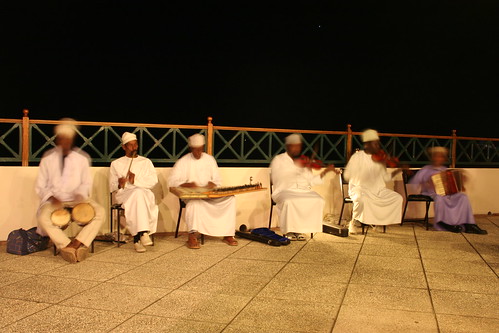
Canon EOS 350D Digital, 30s, f/8, 22mm, ISO 100
Taarab orchesta playing drums, the nay (flute) and the kanun, (zither) at the Serena Inn ocean , Zanzibar Island, Tanzania, East Africa
For arrangements, I highly recommend Fisherman Tours and Travels. The owner, Mr. Arif Mazrui, is a good friend.
Fisherman Tours & Travel Ltd
P. O. Box 3537
Zanzibar, TANZANIA.
Fax.: +255-24-2238790
Tel.: +255-24-2238791/2
Mobile phone: +255-747-440044/441144/412677
E-mail: reservations@fishermantours.com
http://www.fishermantours.com






5 comments:
great post, Farl. a side of Zanzibar that is rarely seen. and of course great photographs!
Charu - from flickr!
http://traveholic.wordpress.com
interesting blog. So often we see a pretty picture and miss the power behind it. I enjoyed getting more of the story behind your flickr set.
pax
Pater JPM (flickr id)
Ahhh, your blog is a delight, dear Farl!
Like a delicious meal. Food for the brain.
charu, fr jpm, monika- great to hear that you enjoyed this post. thanks.
I can really recommend Zanzibar to every one. I was there last year when I traveled to Tanzania for Safari.
Post a Comment